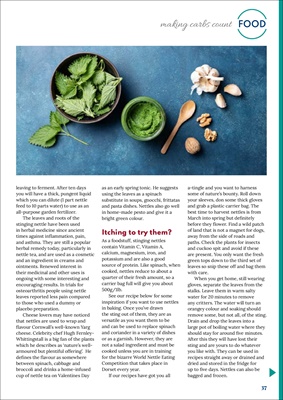
37
FOOD
making carbs count
leaving to ferment. After ten days
you will have a thick, pungent liquid
which you can dilute (1 part nettle
feed to 10 parts water) to use as an
all-purpose garden fertilizer.
The leaves and roots of the
stinging nettle have been used
in herbal medicine since ancient
times against inflammation, pain,
and asthma. They are still a popular
herbal remedy today, particularly in
nettle tea, and are used as a cosmetic
and an ingredient in creams and
ointments. Renewed interest in
their medicinal and other uses is
ongoing with some interesting and
encouraging results. In trials for
osteoarthritis people using nettle
leaves reported less pain compared
to those who used a dummy or
placebo preparation.
Cheese lovers may have noticed
that nettles are used to wrap and
flavour Cornwall's well-known Yarg
cheese. Celebrity chef Hugh FernleyWhittingstall
is a big fan of the plants
which he describes as 'nature's wellarmoured
but plentiful offering'. He
defines the flavour as somewhere
between spinach, cabbage and
broccoli and drinks a home-infused
cup of nettle tea on Valentines Day
as an early spring tonic. He suggests
using the leaves as a spinach
substitute in soups, gnocchi, frittatas
and pasta dishes. Nettles also go well
in home-made pesto and give it a
bright green colour.
Itching to try them?
As a foodstuff, stinging nettles
contain Vitamin C, Vitamin A,
calcium, magnesium, iron, and
potassium and are also a good
source of protein. Like spinach, when
cooked, nettles reduce to about a
quarter of their fresh amount, so a
carrier bag full will give you about
500g/1lb.
See our recipe below for some
inspiration if you want to use nettles
in baking. Once you've drawn
the sting out of them, they are as
versatile as you want them to be
and can be used to replace spinach
and coriander in a variety of dishes
or as a garnish. However, they are
not a salad ingredient and must be
cooked unless you are in training
for the bizarre World Nettle Eating
Competition that takes place in
Dorset every year.
If our recipes have got you all
a-tingle and you want to harness
some of nature's bounty. Roll down
your sleeves, don some thick gloves
and grab a plastic carrier bag. The
best time to harvest nettles is from
March into spring but definitely
before they flower. Find a wild patch
of land that is not a magnet for dogs,
away from the side of roads and
paths. Check the plants for insects
and cuckoo spit and avoid if these
are present. You only want the fresh
green tops down to the third set of
leaves so snip these off and bag them
with care.
When you get home, still wearing
gloves, separate the leaves from the
stalks. Leave them in warm salty
water for 20 minutes to remove
any critters. The water will turn an
orangey colour and soaking should
remove some, but not all, of the sting.
Drain and drop the leaves into a
large pot of boiling water where they
should stay for around five minutes.
After this they will have lost their
sting and are yours to do whatever
you like with. They can be used in
recipes straight away or drained and
dried and stored in the fridge for
up to five days. Nettles can also be
bagged and frozen.